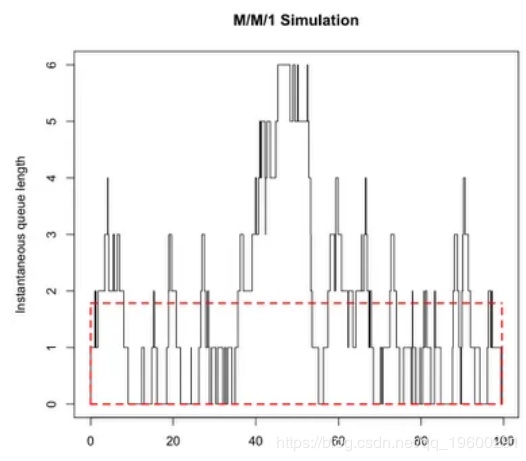原文链接:
http://tecdat.cn/?p=8199tecdat.cn本文中我在R中构造一个简单的M / M / 1队列的离散事件模拟 。
模拟变量
像往常一样,我们从模拟及其检测所需的变量 开始。
t.end <- 10^5 # duration of sim
t.clock <- 0 # sim time
Ta <- 1.3333 # interarrival period
Ts <- 1.0000 # service period
t1 <- 0 # time for next arrival
t2 <- t.end # time for next departure
tn <- t.clock # tmp var for last event time
tb <- 0 # tmp var for last busy-time start
n <- 0 # number in system
s <- 0 # cumulative number-time product
b <- 0 # total busy time
c <- 0 # total completions
qc <- 0 # plot instantaneous q size
tc <- 0 # plot time delta
plotSamples <- 100
set.seed(1)
接下来,我们需要编写R代码以对进入队列和从队列离开进行实际的M / M / 1模拟。
仿真循环
while (t.clock < t.end) {
if (t1 < t2) { # arrival event
t.clock <- t1
s <- s + n * (t.clock - tn) # delta time-weighted number in queue
...
else {
t2 <- t.end
b <- b + t.clock - tb
}
}
}
检测指标
在这里,我们 检测数据以形成一些众所周知的性能指标。
队列长度
这是瞬时队列长度- 平均负载数据的曲线图。这就是排队波动的样子。

显示为红色虚线的框具有与阶梯曲线下方相同的面积。
PDQ模型
为了进行分析比较,我们还使用 PDQ-R模型。
是的,这几行代码与上面带工具的仿真代码等效,并且可以保证处于稳定状态。即使在R中运行PDQ本质上也是瞬时的。模拟将花费更长的时间,
结果
最后,我们可以将模拟的M / M / 1队列与相应的PDQ结果进行比较。像往常一样,最好将它们分解为输入和输出。
- 输入:
Tsim:1.00e + 05
Ta:1.3333,Ts:1.0000#次
Ar:0.7500,Sr:1.0000#
- 输出:
Usim:0.7477,Updq:0.75
Xsim:0.7495,Xpdq:0.75
Rsim:4.0316,Rpdq:4.00
Qsim:3.0219,Qpdq:3.00
我们可以得出结论,仿真在指定的10 5个时间步长内达到了稳态。






















 被折叠的 条评论
为什么被折叠?
被折叠的 条评论
为什么被折叠?








